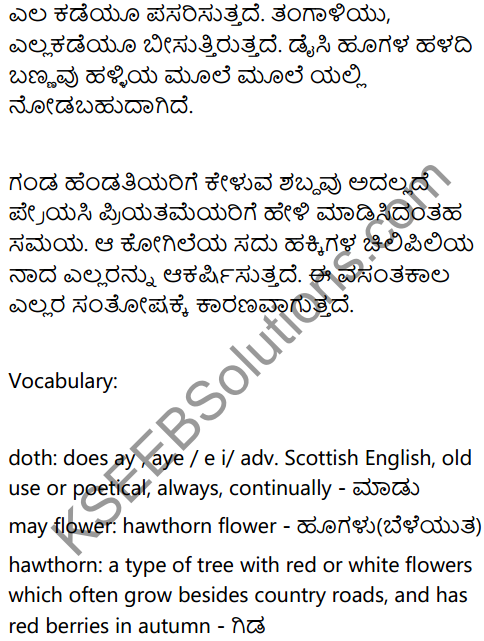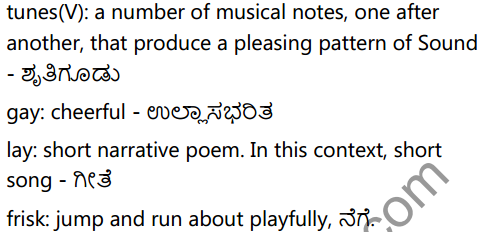KSEEB Class 6 English Poem Chapter 3 Spring Questions and Answers are available for free. You can improve your knowledge within a short period by referring to Karnataka Board Class 6 English Chapter 3 Answers PDF. Download Summary, Notes Pdf, KSEEB Solutions for Class 6 English Chapter Wise Questions and Answer. The best option to learn English is using Karnataka Secondary Education Examination Board Class 6 English Solution Notes. Find the best tips and ways to learn English with the help of the KSEEB Class 6 English Answers PDF. The best practice comes with the Karnataka Board Solutions for Class 6 English PDF. Avoid all the troubles of learning English by taking the help of Karnataka Board Class 6 English Answers.
Karnataka State Board Class 6 English Poem Chapter 3 Spring
Whether you want to become an expert in English or to get good marks in the exam, you have one and only solution is practicing with KSEEB Class 6 English Chapter wise Solutions. Strengthen your weakness by learning the Karnataka Board Class 6 English Poem Chapter 3 Spring on our site. You can learn directly online on our website or learn offline by downloading KSEEB Class 6 English Chapter wise material. Save your time and read KSEEB Class 6 English Subject at your comfort level.
Spring Questions and Answers, Summary, Notes
1. Talk to your partner about the description of spring in the poem. Write down what you say.
KSEEB Solutions For Class 6 English Poem Spring Question a.
Why does the poet consider spring “as the year’s most pleasant season”?
Answer:
All plants, creeper, and trees bloom in spring. It is not cold, the birds sing and the maids dance in joy. So the poet considers spring “as the year’s most pleasant season.
Spring Poem 6th Standard Question b.
Describe the streets of the town in spring.
Answer:
Young lovers meet and old wives sit in the sun to hear cuckoo, jug-jug, joy, pu – we,to witta – too.
Spring Poem Questions And Answers Question c.
In autumn, ripe paddy fields give out a sweet smell, Can you think of a plant or a tree that breathes sweet in spring?
Answer:
- Plant – Jasmine plant
- Creeper – Night queen creeper.
- Tree – Mango tree.
2. In the poem, the poet tells us about the pleasant experiences of the senses in spring. Find examples of the senses of sight, smell, touch, and sound, tell you, friend which ex-ample, you like most and why write down 6 to 8 sentences about what we can see, hear, smell and feel in spring.
example for this.
- sight – blossoms in plants, maids dance, lambs play, lovers meet and old wives sitting.
- smell – the fields.
- touch – daisies kissing our feet
- sound – bird singing cuckoo feet, jug-jug, pu-we, to-witta-too!
3. Writing:
Work with your partner and do this exercise:
“ If winter comes can spring be far behind? This is an English proverb. It says, “ Don’t worry that difficult days have come, pleasant days will follow. In this poem winter is over spring has come. The poet is excited by the changes it has brought with it. He brings out the pleasant experiences of the senses in the spring.
Spring Summary in English
The poem ‘ Spring’ is penned by Thomas Nashe. The Spring season comes after the winter season. Our natural surroundings undergo a lot of changes. The cold dreary weather is replaced by warm sunny weather.
Nature becomes colourful and lively. Inspired by the colourful warmth of the spring season people look cheerful and active. The poet adores the spring season. Spring is a sweet season. It is the most pleasant season of the year. He then goes on to describe the reasons activities of the spring season.
The poet exaggerates says that everything blooms during the spring season. Maybe he is right and it is no exaggeration that everything seems to bloom in the spring season.
People are cheerful and happy inspired, by their colourful surroundings. The young maidens come out to dance in a ring. The springs sun is casting a warm glow taking out the biting cold of the winter season. Pretty birds, such as the cukoo, Jug – Jug, pu-we, to-witta-to (The poet identifies the birdsbythesoundstheymake)come out of their warm nests and start to sing beautifully.
The country houses appear gay and lively surrounded by the green palm trees and may flowers which are swaying in the gentle wind. The lambs which had been cooped inside the bams all winter season arc now let out in the warm weather of the spring Having found freedom, the lambs jump and ran playfully and their shepherds are playing a cheerful song on their pipes. We can also heat the birds such as cuckoo, jug – jug, put-wc and to-witta-to join the shepherds with their merry tunes.
The gentle wind that blows over the green fields bring their sweet freshness, and the diasies which have bloossomed all ove; the country side kiss our feet as we walk along. All over the fields and on the village street we can her the merry tunes of the cuckoo, jug-jug pu-we and to – witta – to greeting the sweet spring season.
The young people who are in love and the old women, hear the birds singing and come out to meet each other in the warm and lively spring weather.
Spring Summary in Kannada



Share this Karnataka Board Class 6 English Poem Chapter 3 Spring with your friends to help them to overcome the grammar issues in exams. Keep visiting this site frequently to get the latest information on different subjects. Clarify your doubts by posting the comments and get the answers in an easy manner.